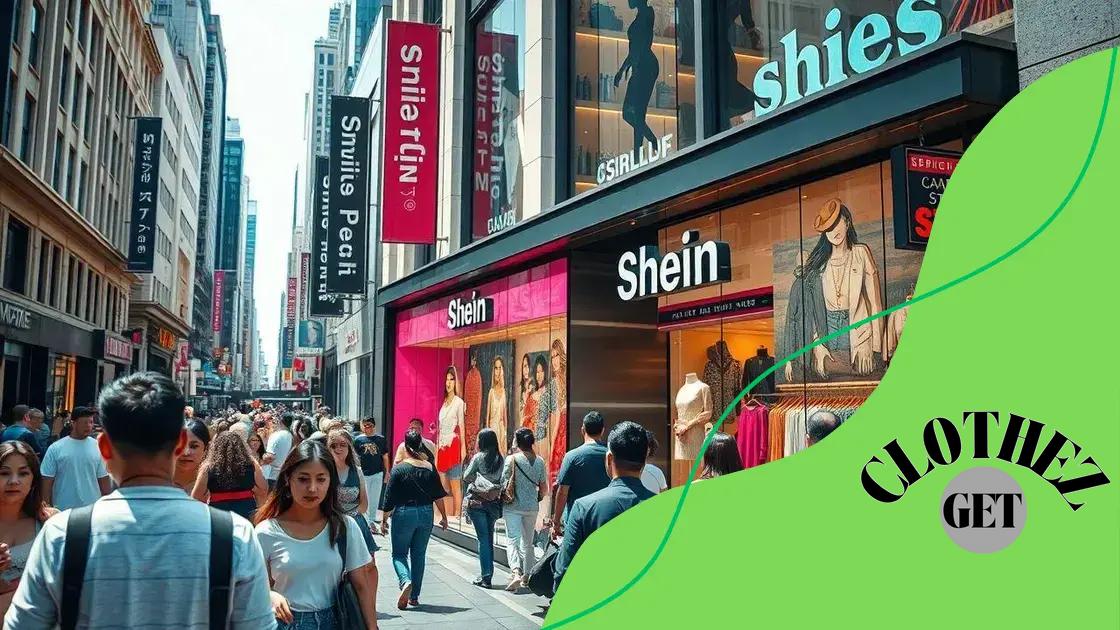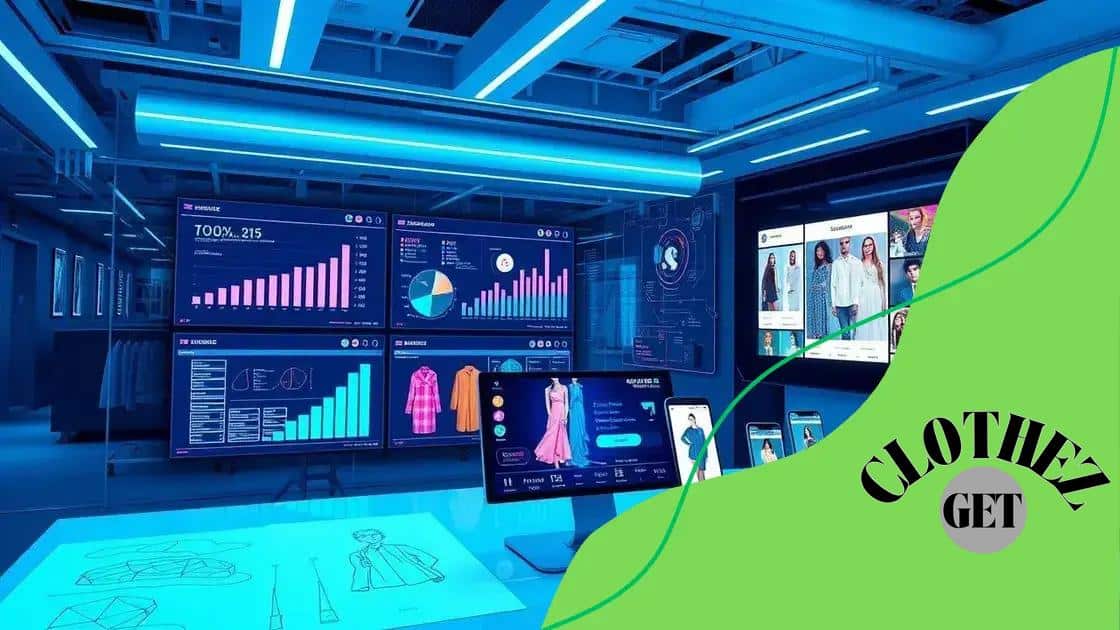Shein’s role in disrupting traditional retail economics

Shein’s role in disrupting traditional retail economics revolves around its fast fashion model, utilizing technology and data to rapidly respond to consumer trends, ultimately reshaping shopping behaviors and market expectations.
Shein’s role in disrupting traditional retail economics is more than just a trend; it’s reshaping how we shop and engage with fashion. Have you noticed how clothing styles shift rapidly, almost overnight? Let’s dive into this retail phenomenon.
Understanding Shein’s business model
Understanding Shein’s business model is key to grasping how it became a leader in fast fashion. This innovative approach changes the way customers shop and brands operate.
One significant aspect is the company’s direct-to-consumer strategy. Shein crafts their offerings by closely monitoring current fashion trends and consumer preferences. This allows them to adapt quickly, keeping their inventory fresh and exciting.
Key Features of Shein’s Model
Some essential components of their business approach include:
- Data-driven decisions: Shein uses big data to track emerging trends and optimize its designs.
- Fast production cycles: They can produce new designs in days rather than months, making them highly responsive to trends.
- Affordability: Shein appeals to budget-conscious shoppers with low prices, ensuring accessibility for a broad audience.
- Global reach: Their online platform allows them to sell to customers worldwide, expanding their market significantly.
This combination of techniques enables Shein to dominate the market while traditional retailers struggle to keep up. In fact, their success demonstrates how important it is for businesses to stay agile and put customer preferences first.
Additionally, user engagement plays a crucial role. Shein interacts with customers through social media platforms, encouraging them to share their fashion choices and experiences. This practice generates a community around the brand, fostering loyalty that is hard for competitors to match.
Moreover, the company’s commitment to promoting a diverse range of styles helps them connect with various demographics. This not only solidifies their position in the market, but also challenges the traditional retail economics that rely on seasonal collections.
Overall, Shein’s approach highlights the need for retailers to innovate continuously. The focus on flexibility and consumer engagement is something all businesses can learn from in today’s competitive landscape.
The impact on consumer behavior
The impact of Shein on consumer behavior is profound and multifaceted. As shoppers have access to an endless array of affordable trends, their purchasing decisions are rapidly changing.
Today’s consumers are more inclined to seek out newer styles at lower prices. This shift in behavior is due in part to Shein’s ability to produce fashion quickly and efficiently.
Key Changes in Consumer Habits
Several significant changes can be observed:
- Increased frequency of purchases: Shoppers now buy clothes more often, driven by the constant availability of new arrivals.
- Impulse buying: The tempting deals and fast fashion trends encourage spontaneous purchases.
- Online shopping preference: The rise of e-commerce has made it easier for consumers to shop anywhere at any time.
- Social media influence: Platforms like Instagram and TikTok amplify trends, impacting buying behavior.
This new approach to shopping fosters a disposable culture where clothing is often seen as temporary. Shoppers prioritize quantity over quality, leading to a cycle where items are worn a few times before being discarded.
Moreover, consumers frequently turn to Shein for inspiration. With abundant styles showcased online, shoppers often find themselves exploring outfits that match their personalities. This visual engagement enhances their shopping experience.
Additionally, Shein’s use of user-generated content creates a sense of community. When shoppers see others wearing the same pieces, it strengthens their bond with the brand and their purchase decisions.
The interaction between Shein and its customers undeniably shapes modern consumer expectations. As traditional brands struggle to catch up, it’s clear that adapting to these new behaviors is crucial for success in the retail landscape.
How Shein leverages technology

How Shein leverages technology plays a crucial role in its rapid growth and success in the fast fashion industry. With advanced systems and tools, the brand effectively meets consumer demands.
A significant part of their strategy involves using big data and analytics. By collecting vast amounts of information on customer preferences and buying habits, Shein can identify trends quickly. This data-driven approach allows them to adjust their inventory and product offerings almost in real-time.
Key Technological Innovations
Some specific technologies utilized by Shein include:
- Predictive analytics: This helps forecast what styles will be popular, enabling the company to produce accordingly.
- Artificial intelligence: AI algorithms streamline the design process, suggesting new styles based on trending colors and designs.
- Automated supply chain: Automation helps manage logistics and inventory, making it easier to fulfill orders quickly.
- Mobile technology: A user-friendly app makes shopping convenient, allowing customers to browse, select, and purchase with ease.
Additionally, Shein’s website is designed to enhance customer engagement. With features like personalized recommendations and user reviews, the shopping experience becomes tailored to individual needs.
Social media platforms also play a crucial role in Shein’s marketing strategy. By utilizing influencer partnerships and user-generated content, they effectively reach a larger audience. This creates a buzz around new releases and promotions, driving traffic to their platform.
Moreover, the seamless integration of technology allows Shein to maintain competitive pricing. By reducing overhead costs and optimizing operations, they pass savings on to consumers. This combination of affordability and trendiness keeps customers coming back for more.
Challenges faced by traditional retailers
Challenges faced by traditional retailers are becoming more evident as brands like Shein reshape the retail landscape. These challenges threaten the stability and growth of long-established companies.
One major hurdle is the shift in consumer behavior toward fast fashion. Customers now expect quick access to the latest styles at affordable prices, a demand that traditional retailers often struggle to meet.
Major Challenges in the Retail Sector
Some specific challenges include:
- Slow inventory turnover: Traditional retailers often have longer lead times, making it difficult to offer fresh products.
- High operating costs: Maintaining physical stores adds to expenses, reducing the ability to compete with e-commerce giants.
- Difficulty in adapting to trends: Traditional retailers may lack the nimbleness required to pivot quickly in response to changing fashion trends.
- Online competition: With the growth of e-commerce, brick-and-mortar stores face stiff competition from online-only retailers.
Furthermore, traditional retailers rely heavily on established seasonal cycles that are becoming less relevant in today’s fast-paced environment. As customers prioritize instant gratification, businesses that cannot adapt will likely lose market share.
The rise of social media influencers has also changed marketing strategies. Traditional retailers often find it challenging to engage younger audiences who are influenced by online personalities instead of conventional advertising.
Additionally, many traditional brands are burdened by legacy systems that hinder quick adaptation to technological advancements. This slow adaptability impacts their ability to leverage data effectively to inform decisions.
In conclusion, the lack of agility, coupled with high operational costs, makes it increasingly difficult for traditional retailers to survive in this competitive landscape.
Future trends in retail influenced by Shein
Future trends in retail are increasingly shaped by the innovative strategies employed by Shein. As the fast fashion giant continues to grow, its influence on the market will likely inspire other brands to adopt similar approaches.
One prominent trend is the rise of personalization. Consumers today expect a shopping experience tailored to their preferences. Shein excels in offering customized recommendations based on user behavior, which enhances customer satisfaction and loyalty.
Emerging Trends in Retail
Several key trends are emerging as retailers adapt to Shein’s success:
- Increased use of technology: Brands will invest more in AI and analytics to improve inventory management and consumer insights.
- Focus on sustainability: As fast fashion faces criticism, retailers will prioritize eco-friendly practices to meet consumer demand for sustainable products.
- Faster supply chains: Companies will streamline their operations to reduce lead times and bring new styles to market quickly.
- Engagement through social media: Retailers will enhance their presence on platforms like Instagram and TikTok to connect with younger customers.
Additionally, the shift toward online shopping is here to stay. Retailers must embrace e-commerce solutions that allow for smooth, user-friendly experiences. Shein’s mobile app serves as an excellent example, providing easy navigation and quick purchasing options.
Moreover, direct communication with consumers is becoming critical. Brands will increasingly use social media and chatbots to interact with customers, creating a more engaging and responsive environment.
As these trends evolve, it becomes essential for traditional retailers to adapt their strategies. Keeping up with Shein’s pace will require grasping technological advancements and understanding changing consumer preferences.
FAQ – Frequently Asked Questions about Shein and Its Impact on Retail
How has Shein changed consumer shopping habits?
Shein has made consumers expect fast fashion at low prices, encouraging more frequent and impulsive purchases.
What challenges do traditional retailers face because of Shein?
Traditional retailers struggle with slow inventory turnover and high operating costs, which makes it hard to compete with Shein’s rapid production.
What trends are emerging in retail due to Shein’s influence?
Emerging trends include a focus on personalization, sustainability, and the integration of advanced technology in retail operations.
How can traditional retailers adapt to the competition from Shein?
By adopting faster supply chains, improving online shopping experiences, and engaging customers through social media.





